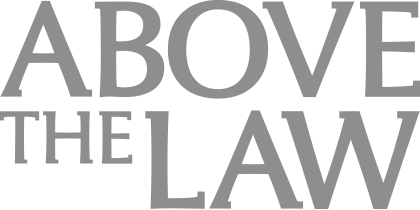CLE With Dr. Seuss: I Do Not Like Jurisdiction In Rem, Said Sam-I-Em
If every CLE event involved extended discussions of elephants hatching eggs, no one would ever be scrambling for credits at the last minute.
The title had flitted into the ATL tips inbox a couple weeks earlier: Exploring Civil Society Through the Writings of Dr. Seuss. The invitation described a seven-hour symposium of legal academics waxing philosophic about the legal lessons one could draw from Hop on Pop.
My instincts told me that this session could be a ludicrous ivory tower circle jerk.
But most importantly, the invitation told me it was $55 for 7 hours of CLE, breakfast, lunch, snacks, and an open wine/beer bar. And with that, I was off to New York Law School to cover the event.

AI Presents Both Opportunities And Risks For Lawyers. Are You Prepared?
Their first mistake was not having green eggs and ham for breakfast. What the hell? I’m unaware of the work in the Seuss oeuvre that focuses on “sesame seed bagels” (ed. note: Thomas the Ox Who Loved Lox). Perhaps we’re too close to St. Patrick’s Day for the city to spare any of its Strategic Green Food Coloring Reserve on non-alcoholic causes.
What did I learn from a day in Whoville? Here are four specific observations….
1. Lawyers Can Be Total Dorks… In a Good Way. The event was inspired by a post written last year by New York Law Professor Tamara Belinfanti, entitled “Corporations in a Lorax State.” The post walked through the plot of The Lorax to suggest the need for a new corporate mission that recognizes the importance of sustainability. Remember The Lorax? The Lorax was a magical, pan-sexual, non-threatening spokesthing for environmentalism who ominously disappeared at the end of the story. He returned to promote the movie by shilling SUVs. Never trust a monster over 30.
Sponsored

Generative AI at Work: Boosting e-Discovery Efficiency for Corporate Legal Teams


Curbing Client And Talent Loss With Productivity Tech

Curbing Client And Talent Loss With Productivity Tech
It’s a dorky move, but Belinfanti’s post got the ball rolling for the New York Law Review put this thing on.
In Belinfanti’s opening remarks on Friday, she introduced us to a replica Lorax that her kid’s class made for the event. It became the unofficial mascot of the proceedings. It even got a speaking role toward the end of the day.
2. Off-Beat Topics Bring Out the Best in Legal Academics. I’ve watched my share of CLEs. Law professors are mind-numbingly boring. The “latest developments” in their chosen area of study come across as desperate pleas for attention: “Look at me! Focusing on the Rule of Perpetuities has finally paid off!” But despite my initial skepticism, it turned out that watching professors shoehorn their field into a Dr. Seuss book actually made for more engaging panels. Asking academics to coax gravity from the seemingly trifling is like waving a cape before a bull. Or a donut in front of Elie.
The intellectual gymnastics of the panelists (more or less) went beyond a latter-day Glass Bead Game, though there was an argument over whether or not JoJo’s “Yop” in Horton Hears a Who! was an allusion to Walt Whitman’s “barbaric yawp” — I mean, Jesus f**king Christ — and started to zero in on some fundamental truths about the legal profession.
At root, the lawyer-reader of Seuss is not too distinct from the intended audience of children. As more than one panelist pointed out, in so many words, the further the panelists attempted to draw legal significance from the books, the clearer it became that legal injustices grow from forced “complexities,” and foregrounding the simplest children’s conception of justice illuminates the proper course for the law.
Sponsored

AI Presents Both Opportunities And Risks For Lawyers. Are You Prepared?

Law Firm Business Development Is More Than Relationship Building
3. Drawing Racist Cartoons Gives You PTSD. Professor Donald Pease, a Seuss biographer, explained the influences that triggered Seuss’s embrace of non-sensical humor as a guise for moral lessons. He cited an essay by Seuss on “conditioned laughter” that basically suggested that all adult humor was based on adults being total douchebags and noted that kids, left to their own devices, like pure fun. Seuss came to his disdain for the exclusionary humor of adults after spending the Second World War drawing all kinds of racist stereotypes, like this.
After the war, Seuss was traumatized by his role in this process and he embraced the wacky — which, when I think about it, parallels my decision to move from private legal practice to writing for ATL. I still have nightmares about practicing, man.
4. Stockholm Syndrome is Real. Look, I kept my bullsh*t meter armed and ready for as long as possible, but over time, the occasional interpretive leaps of the speakers filtered down into a few bedrock truths that I couldn’t help but recognize. That practicing law should constantly re-engage its foundational truths is a valuable legal lesson, and if the path to that lesson is this entertaining, I can’t mock it.
Having a bunch of 4-year-olds put on a play helped. Even I can’t cap on that. And those kids articulated their message better than most partners I’ve seen give talks.
I was completely engaged in a CLE for the first time ever as I always am for every CLE I’ve ever watched to receive credit to maintain my license.
At the end of the day, after grabbing my free Bud Light, I turned to scan the hors d’oeuvres. Well, what do you know? Hard-boiled egg slices with salsa verde along with some meat appetizers. There were green eggs and ham after all. My heart grew two sizes that day. Not three… just two, but it’s a start.
Corporations in a Lorax State [Huffington Post]
Exploring Civil Society Through the Works of Dr. Seuss [NYLS Law Review]







